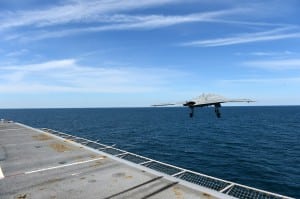
ABOARD THE USS GEORGE H. W. BUSH--The Navy’s X-47B touched down on an aircraft carrier Wednesday, marking the first time an unmanned aerial vehicle has made an arresting gear landing aboard a ship, bringing the service’s effort to operate UAVs off aircraft carriers closer to reality. The Northrop Grumman [NOC]-built X-47B demonstrator landed on the USS George H.W. Bush (CVN-77) sailing off the coast of Virginia. An X-47B launches off a carrier in May. Photo by U.S. Navy In May the Navy conducted…













